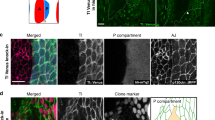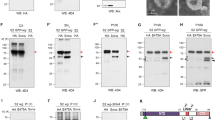Abstract
THE Wnt genes encode secreted glycoproteins used in intercellular communication at multiple steps during development. Signalling by Wingless, the Drosophila Wnt-1 homologue, requires the activity of Armadillo1,2, the homologue of vertebrate β-catenin3, which is a component of the cadherin/catenin complex at adherens junctions4,5. The genetic link between wingless and armadillo suggests that cell fate specification and cell–cell adhesion might be controlled concurrently. For instance, in one extreme view, Wingless could specify cell fate entirely by modulating cell adhesion. Alternatively, it might signal independently of adherens junctions. To distinguish between these alternatives, we have expressed two polypeptides that have opposite effects on cad-herin-dependent adhesion: full-length Drosophila E-cadherin and a dominant-negative truncated form. We found that overexpression of either construct mimics wingless phenotypes, thereby uncoupling changes in adhesion from signalling effects. We demonstrate that both constructs titrate Armadillo from a 'signalling' pool which is functionally distinct from the junctional pool.
This is a preview of subscription content, access via your institution
Access options
Subscribe to this journal
Receive 51 print issues and online access
$199.00 per year
only $3.90 per issue
Buy this article
- Purchase on Springer Link
- Instant access to full article PDF
Prices may be subject to local taxes which are calculated during checkout
Similar content being viewed by others
References
Noordermeer, J., Klingensmith, J., Perrimon, N. & Nusse, Nature 367, 80–83 (1994).
Peifer, M., Sweeton, D., Casey, M. & Wieschaus, E. Development 120, 369–380 (1994).
Peifer, M. J. Cell Sci. 105, 993–1000 (1993).
Tsukita, S., Tsukita, S., Nagatuchi, A. & Yonemura, S. Curr. Opin. Cell Biol. 4, 834–839 (1992).
Stappert, J. & Kemler, R. Curr. Opin. Neurobiol. 3, 60–66 (1993).
Aberle, H. et al. J. Cell Sci. 3655–3663 (1994).
Rimm, D. L., Koslov, E. R., Kebriaei, P., Cianci, C. D. & Morrow, J. S. Proc. Natl Acad. Sci. USA 92, 8813–8817 (1995).
Nagafuchi, A. & Takeichi, M. Cell Regul. 1, 37–44 (1989).
Ozawa, M., Baribault, H. & Kemler, R. EMBO J. 8, 1711–1717 (1989).
Oda, H. et al. J. Cell Biol. 121, 1133–1140 (1993).
Oda, H., Uemura, T., Harada, Y., Iwai, Y. & Tameichi, M. Dev. Biol. 165, 716–726 (1994).
Peifer, M., Orsulic, S., Sweeton, D. & Wieschaus, E. Development 118, 1191–1207 (1993).
Takeichi, M. Annu. Rev. Biochem. 59, 237–252 (1990).
Kintner, C. Cell 69, 225–236 (1992).
Brand, A. H. & Perrimon, N. Development 118, 401–415 (1993).
Uemura, T. et al. Genes Dev. 10, 659–671 (1996).
Tepass, U. et al. Genes Dev. 10, 672–685 (1996).
DiNardo, S., Sher, E., Heemskerk-Jongens, J., Kassis, J. A. & O'Farrell, P. H. Nature 332, 604–609 (1988).
Martinez Arias, A., Baker, N. & Ingham, P. W. Development 103, 157–170 (1988).
Couso, J. P., Bishop, S. A. & Martinez Arias, A. Development 120, 621–636 (1994).
Diaz Benjumea, F. & Cohen, S. M. Development 121, 4215–4225 (1995).
Sharma, R. P. & Chopra, V. L. Dev. Biol. 48, 461–465 (1976).
Ozawa, M., Ringwald, M. & Kemler, R. Proc. Natl Acad. Sci. USA 87, 4246–4250 (1990).
Aberle, H., Schwartz, H., Hoschuetzky, H. & Kemler, R. J. Biol. Chem. 271, 1520–1526 (1996).
Heasman, J. et al. Cell 79, 791–803 (1994).
Funayama, N., Fagotto, F., McCrea, P. & Gumbiner, B. M. J. Cell Biol. 128, 959–968 (1995).
Orsulic, S. & Peifer, M. J. Cell Biol. 134, 1283–1300 (1996).
Grawe, F., Wodarz, A., Lee, B., Knust, E. & Skaer, H. Development 122, 951–959 (1996).
Fagotto, F., Funayama, N., Glück, U. & Gumbiner, B. J. Cell Biol. 132, 1105–1114 (1996).
Hinck, L., Nathke, I. S., Papkoff, J. & Nelson, W. J. Trends Biochem. Sci. 19, 538–542 (1994).
Author information
Authors and Affiliations
Rights and permissions
About this article
Cite this article
Sanson, B., White, P. & Vincent, JP. Uncoupling cadherin-based adhesion from wingless signalling in Drosophila. Nature 383, 627–630 (1996). https://doi.org/10.1038/383627a0
Received:
Accepted:
Issue Date:
DOI: https://doi.org/10.1038/383627a0
This article is cited by
-
Rab11 negatively regulates wingless preventing JNK-mediated apoptosis in Drosophila epithelium during embryonic dorsal closure
Cell and Tissue Research (2023)
-
Wnt6 plays a complex role in maintaining human limbal stem/progenitor cells
Scientific Reports (2021)
-
The Drosophila melanogaster Neprilysin Nepl15 is involved in lipid and carbohydrate storage
Scientific Reports (2021)
-
Cadherins in early neural development
Cellular and Molecular Life Sciences (2021)
-
Cancer cell-intrinsic function of CD177 in attenuating β-catenin signaling
Oncogene (2020)
Comments
By submitting a comment you agree to abide by our Terms and Community Guidelines. If you find something abusive or that does not comply with our terms or guidelines please flag it as inappropriate.



